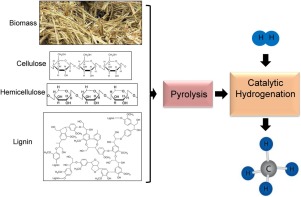当前位置:
X-MOL 学术
›
J. Anal. Appl. Pyrol.
›
论文详情
Our official English website, www.x-mol.net, welcomes your feedback! (Note: you will need to create a separate account there.)
Pyrolysis-Catalytic Hydrogenation of Cellulose-Hemicellulose-Lignin and Biomass Agricultural Wastes for Synthetic Natural Gas Production
Journal of Analytical and Applied Pyrolysis ( IF 6 ) Pub Date : 2020-01-01 , DOI: 10.1016/j.jaap.2019.104753 Mohammad M. Jaffar , Mohamad A. Nahil , Paul T. Williams
Journal of Analytical and Applied Pyrolysis ( IF 6 ) Pub Date : 2020-01-01 , DOI: 10.1016/j.jaap.2019.104753 Mohammad M. Jaffar , Mohamad A. Nahil , Paul T. Williams

|
Abstract The production of methane from the biopolymers; cellulose, hemicellulose and lignin, and also four different agricultural waste biomass samples was investigated using a two-stage pyrolysis-catalytic hydrogenation reactor. The biomass agricultural waste samples were rice straw, willow, sugar cane bagasse and ugu plant. Pyrolysis of the biomass samples was carried out in a 1st stage reactor while the catalytic hydrogenation was carried out the 2nd stage reactor using a 10 wt.% Ni/Al2O3 catalyst maintained at 500 °C with heating rate of 20 °C min−1 and a H2 space velocity of 3600 ml h−1 g−1catalyst. The thermal degradation characteristics of the biomass components, mixtures of the components and the biomass waste samples was also conducted using thermogravimetric analysis (TGA). TGA of the mixtures of the biomass components showed interaction, illustrated by a shift in the thermal degradation temperatures for hemicellulose and lignin. The results from the pyrolysis-catalytic hydrogenation revealed that the methane yield increased in the presence of the catalyst; the methane yield obtained from the hemicellulose (7.9 mmoles g−1biomass) and cellulose (7.65 mmoles g−1biomass) was significantly higher than that produced from lignin, (3.7 mmoles g−1biomass). The pyrolysis-catalytic hydrogenation of the mixtures of the biopolymers showed clear interaction, producing higher total gas yield and methane yield compared to calculated values. Pyrolysis-catalytic hydrogenation of the agricultural biomass wastes suggests that the product methane yield was influenced by the percentage of hemicellulose and cellulose content in the biomass.
中文翻译:

用于合成天然气生产的纤维素-半纤维素-木质素和生物质农业废物的热解-催化加氢
摘要 从生物聚合物生产甲烷;使用两级热解-催化加氢反应器研究了纤维素、半纤维素和木质素以及四种不同的农业废弃物生物质样品。生物质农业废弃物样品为稻草、柳树、甘蔗渣和乌谷植物。生物质样品的热解在第一阶段反应器中进行,而催化氢化在第二阶段反应器中进行,使用 10 wt.% Ni/Al2O3 催化剂保持在 500 °C,加热速率为 20 °C min-1 和3600 ml h-1 g-1 催化剂的 H2 空间速度。还使用热重分析 (TGA) 进行了生物质组分、组分混合物和生物质废物样品的热降解特性。生物质组分混合物的 TGA 显示出相互作用,这通过半纤维素和木质素的热降解温度的变化来说明。热解-催化加氢结果表明,催化剂存在下甲烷产率增加;从半纤维素(7.9 mmoles g-1biomass)和纤维素(7.65 mmoles g-1biomass)获得的甲烷产量显着高于从木质素产生的甲烷产量(3.7 mmoles g-1biomass)。生物聚合物混合物的热解-催化氢化显示出明显的相互作用,与计算值相比,产生更高的总气体产率和甲烷产率。
更新日期:2020-01-01
中文翻译:

用于合成天然气生产的纤维素-半纤维素-木质素和生物质农业废物的热解-催化加氢
摘要 从生物聚合物生产甲烷;使用两级热解-催化加氢反应器研究了纤维素、半纤维素和木质素以及四种不同的农业废弃物生物质样品。生物质农业废弃物样品为稻草、柳树、甘蔗渣和乌谷植物。生物质样品的热解在第一阶段反应器中进行,而催化氢化在第二阶段反应器中进行,使用 10 wt.% Ni/Al2O3 催化剂保持在 500 °C,加热速率为 20 °C min-1 和3600 ml h-1 g-1 催化剂的 H2 空间速度。还使用热重分析 (TGA) 进行了生物质组分、组分混合物和生物质废物样品的热降解特性。生物质组分混合物的 TGA 显示出相互作用,这通过半纤维素和木质素的热降解温度的变化来说明。热解-催化加氢结果表明,催化剂存在下甲烷产率增加;从半纤维素(7.9 mmoles g-1biomass)和纤维素(7.65 mmoles g-1biomass)获得的甲烷产量显着高于从木质素产生的甲烷产量(3.7 mmoles g-1biomass)。生物聚合物混合物的热解-催化氢化显示出明显的相互作用,与计算值相比,产生更高的总气体产率和甲烷产率。



























 京公网安备 11010802027423号
京公网安备 11010802027423号